Introduction
Ancient Egyptian Diet was more than just daily meals—it was the foundation of life, health, and spirituality in the Land of the Nile… From simple bread and beer that fueled workers to the luxurious feasts enjoyed by Pharaohs, food reflected both survival and status. Grains, vegetables, fruits, and fish made up everyday meals, while offerings of bread, onions, and figs were placed in temples and tombs as sacred gifts. By exploring what Egyptians ate, we uncover how food shaped their culture, economy, and connection to the afterlife.
Food in ancient Egypt wasn’t just about survival—it was the fuel of a civilization, a reflection of status, health, and spirituality. From the humblest farmers to the mighty Pharaohs, the ancient Egyptian diet shaped daily life, religion, and even the afterlife. In this blog, we’ll uncover the superfoods, grains, vegetables, fruits, and drinks that sustained the land of the Pharaohs.
🌾 Ancient Egyptian Grains – The Heart of Their Meals
If one ingredient defined ancient Egyptian food, it was grain. Barley and emmer wheat were the backbone of Egyptian meals, forming bread and beer that everyone consumed daily.
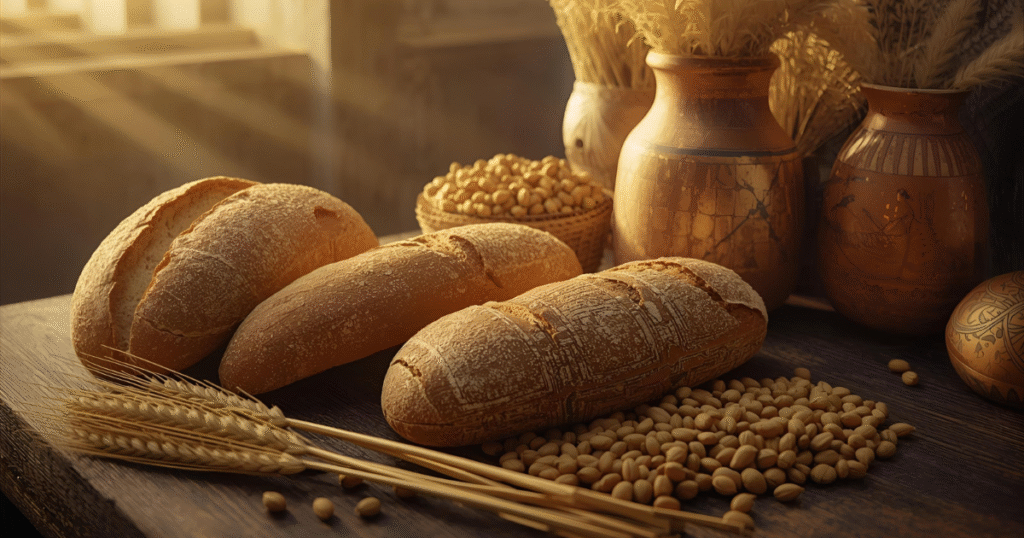
Barley – Bread and Beer for All
Barley was one of the most important crops of ancient Egypt. It was ground into flour for baking bread and fermented to brew beer, which was consumed daily by both the rich and the poor. This wasn’t modern beer—it was thick, nutritious, and full of calories, earning it the nickname “liquid bread.” Barley was also linked with fertility and abundance, making it a staple in both meals and rituals.
🌾 Emmer Wheat – The Pharaohs’ Flour
Unlike modern wheat, emmer wheat had a tougher husk, but it was the backbone of Egyptian baking. Egyptians used stone grinders to crush the wheat, turning it into flour that was baked into flatbreads, loaves, and even pastries for the wealthy. Bread came in hundreds of shapes—round, triangular, animal-shaped—and was flavored with honey, dates, or herbs. For the Pharaohs, bread wasn’t just food—it was an offering of life, symbolizing prosperity and divine favor.
🥖 Bread – More Than Just Food
Bread was more than a meal; it was a symbol of survival and community. Workers received bread as part of their wages, and it was a daily staple for farmers, priests, and royalty alike. In temples, loaves of bread were presented to the gods as sacred offerings. In tombs, bread was buried alongside the dead to ensure nourishment in the afterlife. Its cultural and religious significance shows why bread is often called the “staff of life” in ancient Egypt.Bread and beer were staples, just like in other ancient cultures. Learn more about How Ancient Mesopotamians Cooked with Clay Ovens
🍺 Beer – The Everyday Drink
Beer, made primarily from barley, wasn’t just for leisure—it was essential. Egyptians of all classes, including children, drank beer daily because it was safer than water, which could be contaminated. It provided hydration, energy, and nutrition in one cup. For workers, it was part of their rations; for the wealthy, it was flavored with fruits and herbs to make it more refined. Beer was even offered to the gods, highlighting its role as both a staple and a sacred drink.
Bread was eaten daily and came in many shapes and flavors. For the Egyptians, grains weren’t just food—they were wealth. Farmers paid taxes in grain, and it was even stored in temples as offerings to the gods.Beer – The Everyday Drink
Beer was safer than water and provided energy, hydration, and nutrition. Workers received it as rations, while the wealthy flavored it with fruits and herbs. Even the gods received beer as offerings.
By looking at what Egyptians ate daily, we can see they had a diet rich in nutrients that supported both farmers working in the fields and Pharaohs ruling from their palaces.
Ancient Egyptian Vegetables – The Pharaohs’ Superfoods
Vegetables were not just side dishes in the Egyptian diet—they were everyday essentials that provided energy, healing properties, and even spiritual meaning. Ancient Egyptians believed that certain vegetables carried magical or medicinal powers, and many were used both as food and as natural remedies. These humble plants were so valued that they appeared in tomb paintings, temple offerings, and even medical papyri.
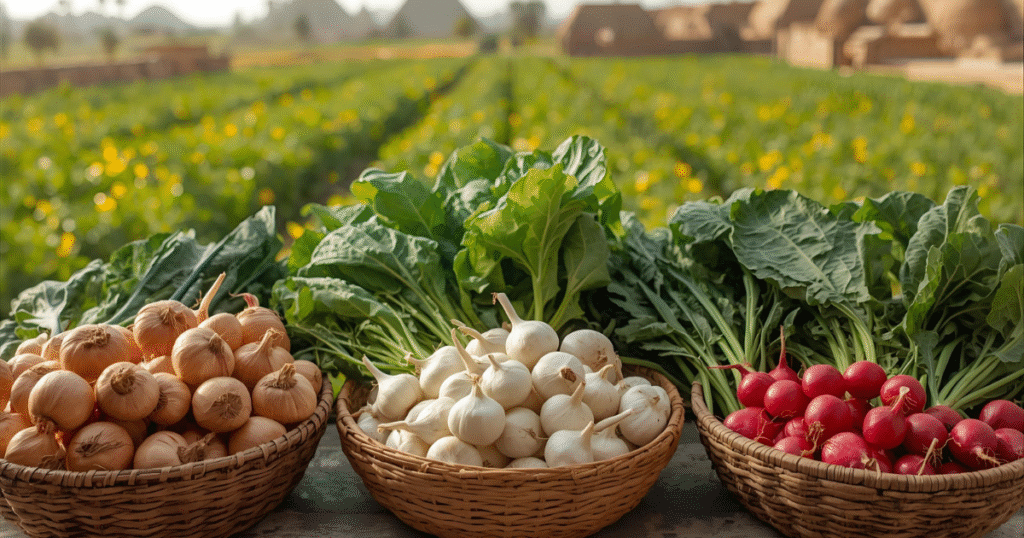
🧅 Onions and Garlic – Strength for the Living and the Dead
Onions and garlic were the most important vegetables in ancient Egypt. Workers who built the pyramids were given rations of garlic and onions because they were thought to boost strength, stamina, and immunity. These vegetables also had spiritual significance: onions, with their circular layers, symbolized eternal life. Archaeologists have even discovered onions placed inside mummies’ bodies, showing their importance in both health and the afterlife.
🥬 Lettuce – Food of Fertility and Rituals
Lettuce wasn’t just a refreshing vegetable in the Egyptian climate—it was linked with fertility and the god Min, associated with reproduction. The Egyptians believed lettuce had properties that promoted vitality and health. It was eaten fresh, added to meals, and sometimes used in offerings to gods. Its cultural role shows how deeply food was tied to religion and everyday life.
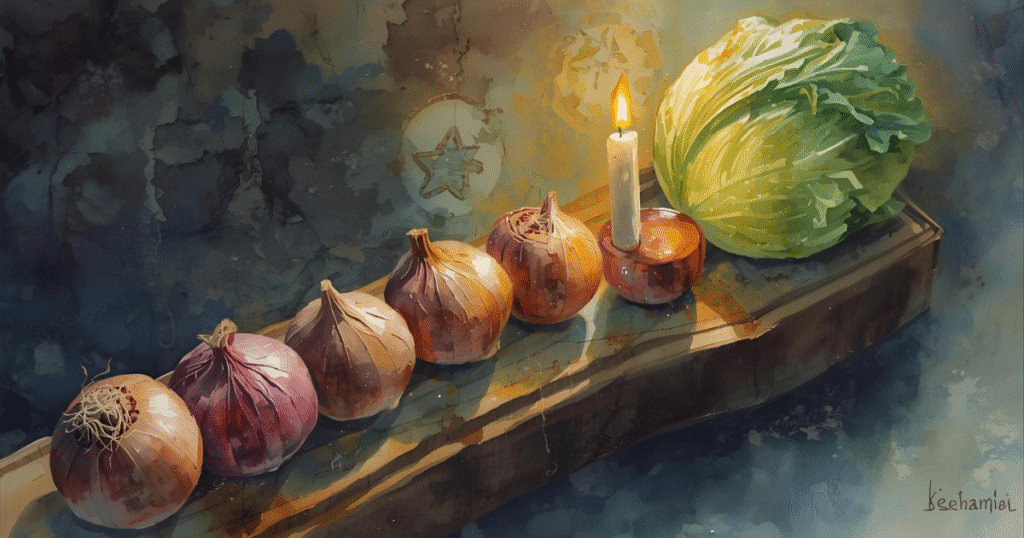
🥒 Cucumbers and Radishes – Refreshment in the Desert
Living in the hot, arid climate of Egypt, cucumbers and radishes were popular for their cooling and hydrating effects. Cucumbers were eaten raw or pickled, while radishes provided a sharp flavor and important minerals. These vegetables were easily grown along the Nile’s fertile banks and added balance to a grain-heavy diet.
🌿 Herbs and Other Greens – Medicine in the Kitchen
Beyond the main vegetables, herbs like coriander, parsley, and dill were commonly used to season food and treat ailments. Coriander seeds, for instance, were believed to aid digestion, while dill was used in both cooking and medicine. Ancient Egyptian papyri reveal recipes where herbs and vegetables were blended into healing remedies, showing the dual role of plants as food and medicine.
These ancient Egyptian vegetables were more than food—they were seen as gifts from the gods. Today, nutritionists would call them natural superfoods because of their health benefits.
🍇 Fruits in Ancient Egypt – Sweet Gifts of the Nile
While grains and vegetables formed the base of the Egyptian diet, fruits added sweetness, variety, and symbolism. Thanks to the fertile lands along the Nile, Egyptians enjoyed a wide range of fruits that provided energy, nutrition, and even spiritual meaning. Many fruits were eaten fresh, dried for preservation, or used as sweeteners in bread, beer, and desserts.
🍇 Grapes – From Vineyards to Wine
Grapes were highly valued in ancient Egypt, especially among the wealthy. They were eaten fresh, dried into raisins, or pressed into juice. Most importantly, grapes were used to produce wine, which was considered a luxury drink reserved for Pharaohs, priests, and the elite. Vineyards were carefully cultivated, and jars of wine were often buried in tombs to accompany the dead in the afterlife. Wine also played a role in religious rituals, symbolizing life and divine blessing.
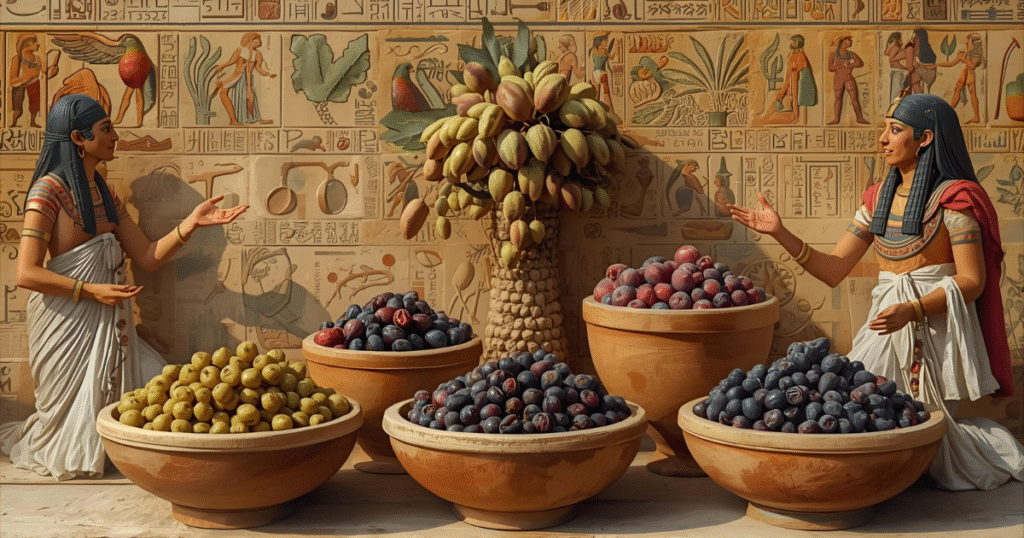
🌴 Dates – The Natural Sweetener
Dates were one of the most common and beloved fruits of Egypt. Grown abundantly on palm trees along the Nile, dates were eaten fresh, dried, or ground into a paste used to sweeten bread and beer. They were rich in energy and easy to preserve, making them a vital food for workers and travelers. Dates also carried symbolic meaning, often associated with fertility and abundance.
🌿 Figs – Nourishment and Symbolism
Figs were another staple fruit, often eaten fresh or dried. Their natural sweetness made them a favorite addition to meals, and they were also used in offerings to the gods. In Egyptian art and hieroglyphs, fig trees often symbolized prosperity and nourishment. Archaeologists have found baskets of dried figs in tombs, a testament to their importance in both daily life and the afterlife.
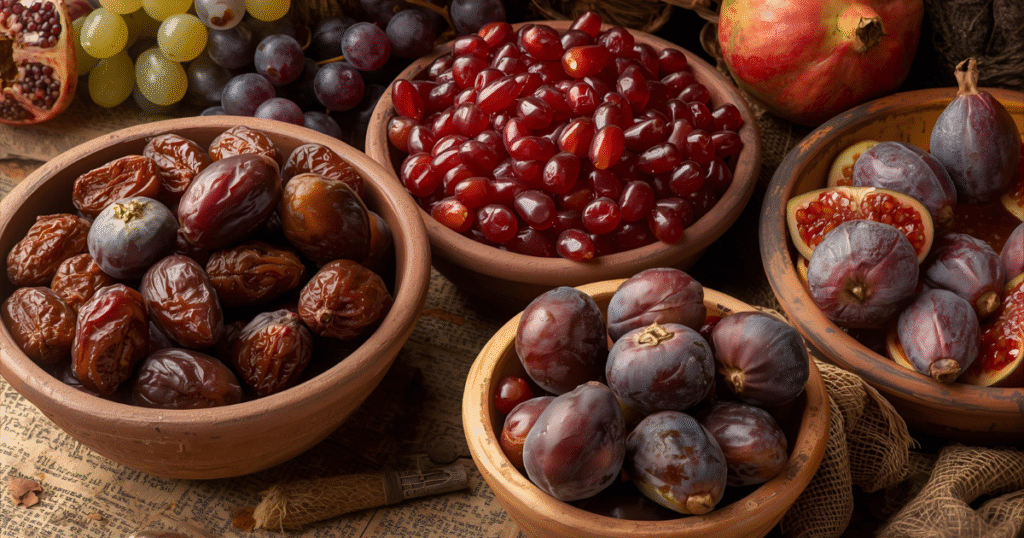
🍏 Other Fruits – Variety from the Nile’s Bounty
In addition to grapes, dates, and figs, Egyptians also enjoyed pomegranates, melons, and sycamore figs (a native variety). Pomegranates, in particular, were prized for their vibrant color and juice, sometimes used in medicine and religious rituals. Melons provided a refreshing treat in the hot climate, while sycamore figs were widely available and easy to grow.
These superfoods helped Egyptians maintain strength and endurance in harsh conditions. The Pharaohs’ diet was centuries ahead of its time, blending nutrition with taste.

🐟 Protein in Ancient Egypt – From the Nile to the Fields
Protein sources varied by class, with both plant-based and animal foods contributing to the diet.
Fish from the Nile
Fish was affordable and common, eaten fresh or dried. Catfish, perch, and tilapia were widely consumed.
Meat and Poultry – Food of the Rich
The wealthy ate beef, goose, and duck, often roasted for feasts. For ordinary people, meat was rare, saved for special occasions.
Legumes – Everyday Protein
Lentils, chickpeas, and beans were staples for the poor and workers. Nutritious and filling, they were turned into stews and soups.
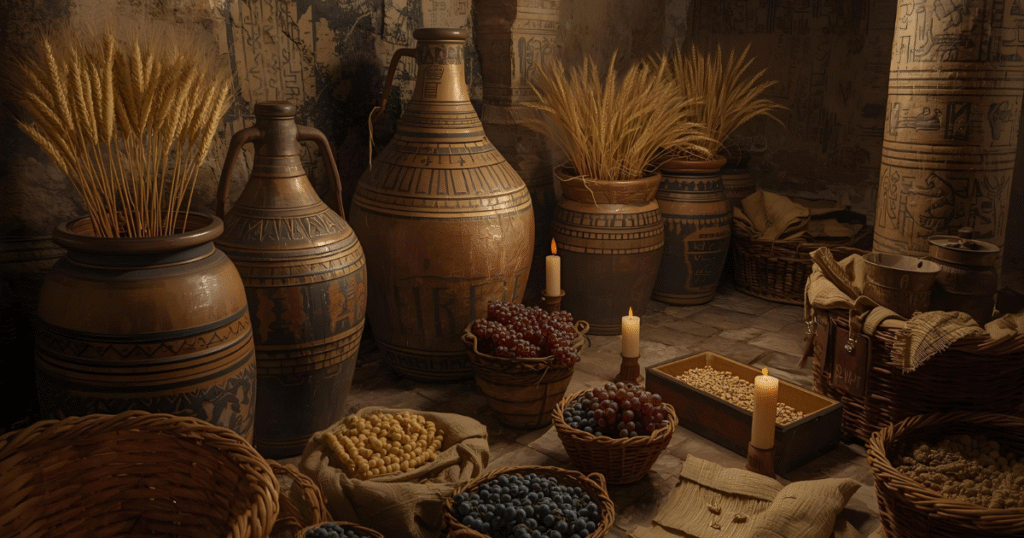
🍺 Drinks in Ancient Egypt – Beer and Wine
Beer – The Drink of the People
Beer was consumed daily by all classes, thick, nutritious, and vital for hydration.
Wine – A Royal Luxury
Wine, made from grapes, was reserved for the elite and used in religious ceremonies. Its presence in tombs shows its spiritual significance.
The Pharaohs’ Diet – Food, Health, and Power
In ancient Egypt, food was more than just a way to survive—it was a reflection of social class, health, and even spirituality. What you ate often revealed who you were. Pharaohs, priests, and workers all shared a foundation of bread, beer, and vegetables, but their diets differed in luxury, variety, and meaning.
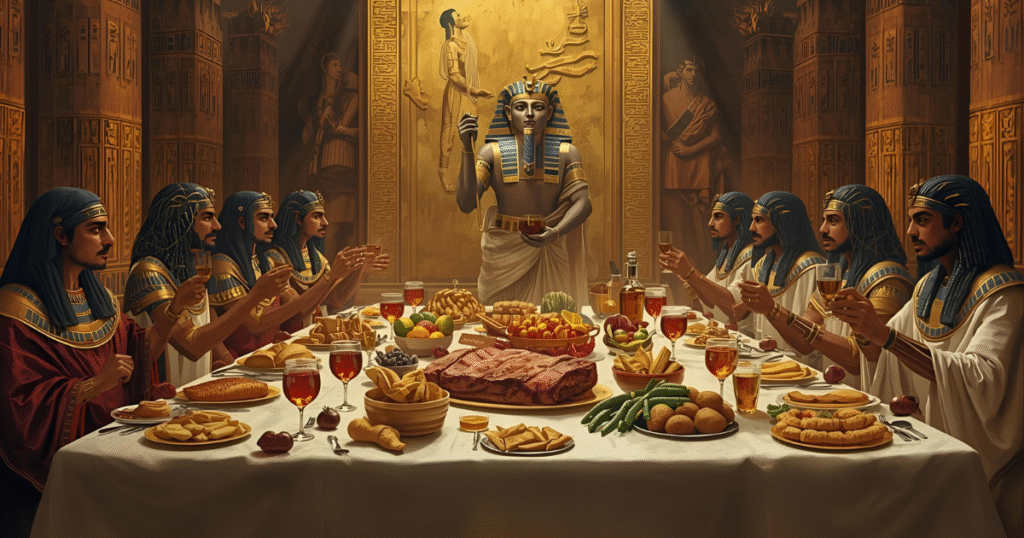
👑 Pharaohs and Royalty – A Taste of Luxury
For Pharaohs and the royal family, food was a symbol of divine power. They dined on the finest cuts of meat, including beef, goose, and duck, along with rare delicacies such as honey and imported fruits. Grapes, dates, and figs often appeared at royal banquets, while wine flowed at feasts. Yet, despite their wealth, even the Pharaohs relied heavily on grains, bread, and vegetables—the same staples eaten by commoners. This blend of luxury and simplicity highlights how deeply Egyptian culture revolved around the bounty of the Nile.
🛕 Priests – Eating for Purity and Ritual
Priests had a very different relationship with food. Since they were responsible for maintaining ritual purity and serving in temples, their diet followed strict rules. Meat was often avoided, as it was considered impure in religious contexts. Instead, priests ate grains, fruits, and vegetables, often prepared in the simplest ways. Offerings of food made to the gods in temples, such as bread, beer, onions, and figs, also reflected what priests consumed daily. Their diet was not about indulgence—it was about discipline, purity, and devotion to the gods.
🧑🌾 Workers and Farmers – Fuel for Hard Labor
The workers who built Egypt’s monuments, including the great pyramids, needed energy-rich foods to sustain long hours of labor. Their meals were simple but filling: bread made from barley or emmer wheat, beer thick enough to be called “liquid bread,” onions for strength, and fish from the Nile. Meat was rare but occasionally provided as a reward during large projects. This diet, though plain compared to the Pharaohs’, provided the calories and nutrients needed for survival and physical endurance.grains and vegetables as everyone else.
The Pharaohs’ diet not only fueled their massive building projects but also became part of their religious life. Many tombs depict offerings of food to ensure the dead were nourished in the afterlife.
🏺 Food and Spirituality – More Than Nourishment
Food wasn’t just fuel in Egypt—it was tied to the gods, the afterlife, and symbolism. Offerings of bread, beer, onions, and figs were left in temples, while tombs were stocked with food to feed souls in eternity. For Egyptians, eating was both a necessity and a pathway to divine connection.
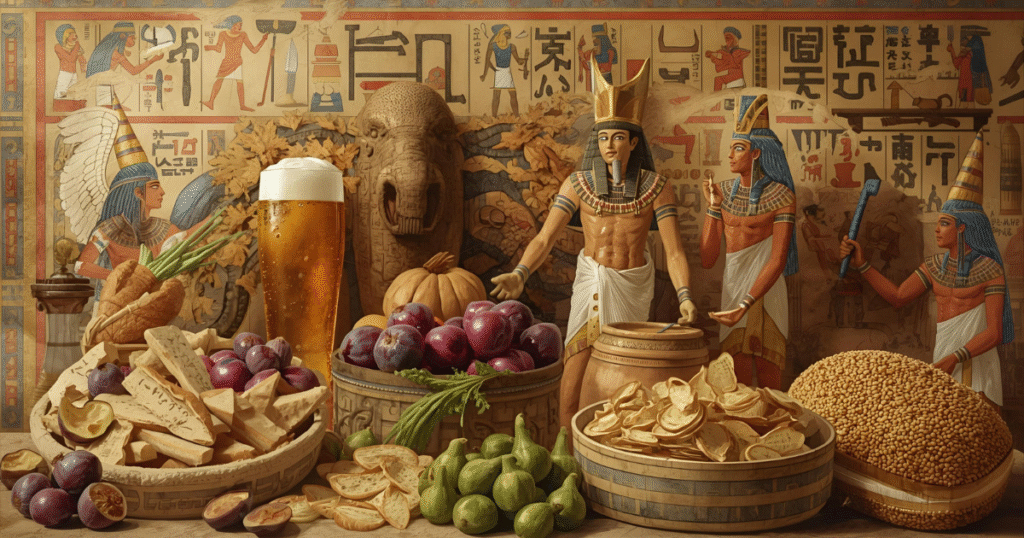
3 Lessons from Ancient Egyptian Food History
Looking back at ancient food history in Egypt, we see valuable lessons for today:
- Balanced Plant-Based Eating: Egyptians ate mostly vegetables, grains, and legumes—similar to modern healthy diets.
- Natural Superfoods: Many foods they ate are still praised today by nutritionists.
- Food as Culture: Their meals weren’t just about health but also religion, celebration, and identity.
By studying ancient Egyptian food history, we can learn how simple, natural diets supported both ordinary farmers and powerful Pharaohs.
🥗 Ancient Egyptian Foods vs Modern Superfoods
| Ancient Egyptian Food | How They Used It | Modern Superfood Equivalent | Health Benefits |
|---|---|---|---|
| Onions & Garlic | Daily meals, worker rations, medicine | Garlic supplements, immune boosters | Boosts immunity, heart health |
| Lettuce | Eaten fresh, linked to fertility rituals | Leafy greens (kale, spinach) | Rich in vitamins, supports digestion |
| Barley & Emmer Wheat | Bread, beer, daily staple | Whole grains, quinoa, oats | Fiber, energy, digestive health |
| Figs & Dates | Sweeteners, snacks, offerings | Energy bars, natural sweeteners | High in antioxidants, natural sugar |
| Flax Seeds | Oil, bread ingredient | Omega-3 supplements, chia seeds | Heart health, digestion, energy |
| Lentils & Chickpeas | Soups, stews, plant protein | Vegan protein, hummus | Protein, iron, balanced diet |
| Cucumbers & Radishes | Refreshing food in hot climate | Hydrating veggies in detox diets | Hydration, minerals, cooling effect |
❓ Frequently Asked Questions About Ancient Egyptian Food
1. What did ancient Egyptians eat every day?
Ancient Egyptians ate bread, beer, vegetables like onions and garlic, and fruits such as figs and dates. Grains were the foundation of their diet, making bread the most common daily food.
2. What vegetables did ancient Egyptians eat?
They consumed onions, garlic, lettuce, cucumbers, and radishes. These vegetables were not only everyday food but also considered powerful healing foods and sometimes used in religious rituals.
3. What grains were most important in the Egyptian diet?
Barley and emmer wheat were the two main grains. They were used to make bread, beer, and even offerings to the gods.
4. Did Pharaohs eat different foods than common people?
Yes, Pharaohs and the wealthy had access to luxury items like honey, wine, and exotic fruits. However, their diet still relied heavily on the same grains, vegetables, and legumes that ordinary Egyptians ate.
5. Are ancient Egyptian foods still considered healthy today?
Absolutely! Many of the foods Egyptians ate—like lentils, flax seeds, figs, and dates—are now recognized as modern superfoods, packed with protein, fiber, and antioxidants.
📝 Conclusion
The Ancient Egyptian Diet was far more than nourishment—it was a symbol of life, power, and spirituality. From humble loaves of bread and jars of beer to royal feasts filled with honey, meat, and wine, food connected every Egyptian, whether worker or Pharaoh, to the rhythms of the Nile. Even in death, meals followed them, offered in tombs to sustain souls in eternity.
By studying what Egyptians ate, we gain a deeper understanding of their daily lives, culture, and beliefs. It reminds us that food is not only about survival but also about identity, tradition, and meaning.
👉 What part of the Egyptian diet surprised you the most—bread and beer as everyday staples, or the sacred offerings for the afterlife? Share your thoughts in the comments!

Pingback: The Legendary 5,000-Year History of Sourdough Bread: From Ancient Egypt to Today”